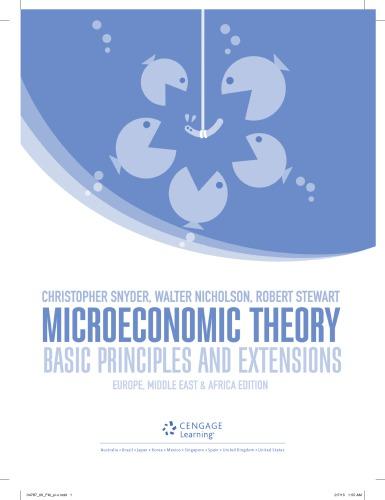15.2 Suppose instead that there are two irms in the market facing the demand and cost conditions...
Question:
15.2 Suppose instead that there are two irms in the market facing the demand and cost conditions just described for their identical products. Firms choose quantities simultaneously as in the Cournot model. Compute the outputs in the Nash equilibrium. Also compute market output, price and irm proits.
Suppose the two irms choose prices simultan eously as in the Bertrand model. Compute the prices in the Nash equilibrium. Also compute irm output and proit as well as market output.
Graph the demand curve and indicate where the market price–quantity combinations from parts
(a)–
(c) appear on the curve.
Suppose that firms’ marginal and average costs are con stant and equal to c and that inverse market demand is given by P = a − bQ, where
a, b > 0.
a.
Calculate the proit-maximising price–quantity combination for a monopolist. Also calculate the monopolist’s proit.
b.
c.
d.
e.
Calculate the Nash equilibrium quantities for Cournot duopolists, which choose quantities for their identical products simultaneously. Also compute market output, market price, and irm and industry proits.
Calculate the Nash equilibrium prices for Bertrand duopolists, which choose prices for their identical products simultaneously. Also compute irm and market output as well as irm and industry proits.
Suppose now that there are n identical irms in a Cournot model. Compute the Nash equilibrium quantities as functions of n. Also compute market output, market price, and irm and industry proits.
Show that the monopoly outcome from part (a)
can be reproduced in part
(d) by setting n = 1, effect in the long run is that entry – which tends to reduce oligopoly proit – will be more attractive.
● Innovation may be even more important than low prices for total welfare in the long run. Determining which oligopoly structure is the most innovative is dificult because offset ting effects (dissipation and replacement) are involved.
that the Cournot duopoly outcome from part (b)
can be reproduced in part
(d) by setting n = 2 in part (d), and that letting n approach ininity yields the same market price, output and industry proit as in part (c).
Step by Step Answer:

Microeconomic Theory Basic Principles And Extensions
ISBN: 9781473729483
1st Edition
Authors: Christopher M Snyder, Walter Nicholson, Robert B Stewart






